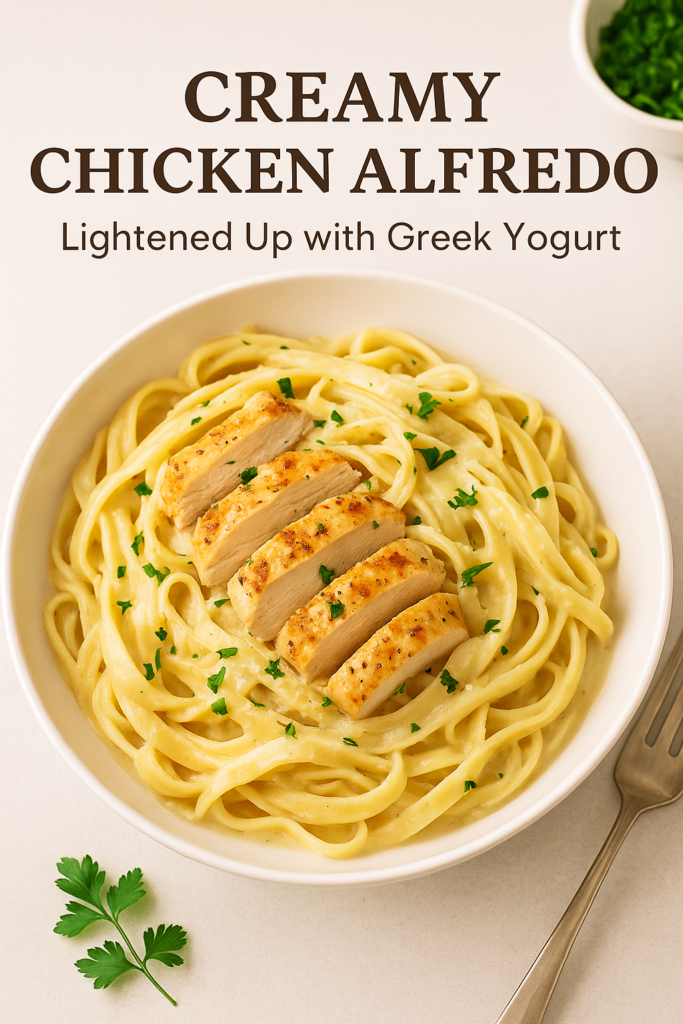
If you’re a fan of Chicken Alfredo, but not the heavy feeling that often comes with it, you’re in for a treat.
This lighter twist swaps out heavy cream for creamy, protein-packed Greek yogurt — keeping all the rich, indulgent flavor you love, while adding a nourishing boost.
In this post, we’ll walk through why this Chicken Alfredo recipe is better for you, the exact ingredients you’ll need, step-by-step instructions, handy cooking tips, and some simple swaps to customize it.
Plus, we’ll share helpful kitchen essentials to make your lightened-up pasta nights even smoother!
🍽️ Why Lighten Up Your Chicken Alfredo?
Chicken Alfredo has earned its place as one of the ultimate comfort foods — creamy, rich, and deeply satisfying.
But that comfort often comes at a cost. Traditional recipes are loaded with heavy cream, butter, and heaps of cheese. And while there’s nothing wrong with the occasional indulgence, turning to this dish regularly can leave you feeling sluggish and bloated, and can work against your wellness goals.
Here’s why giving your Chicken Alfredo a wholesome makeover is one of the best kitchen moves you can make:
1. ✅ Reduce Excess Calories Without Sacrificing Flavor
A typical restaurant-style Chicken Alfredo can contain over 1,000–1,200 calories per serving, thanks to the heavy cream and butter base. That’s often more than half a day’s worth of calories in one meal.
By swapping in Greek yogurt for heavy cream, you cut the fat dramatically while still achieving that silky, creamy texture. You’ll enjoy the same satisfying mouthfeel — without the post-meal crash.
🧪 According to the USDA, 1 cup of heavy cream contains over 800 calories and 88 grams of fat, while the same amount of whole milk Greek yogurt has just about 220 calories and 11 grams of fat[^1].
2. 💪 Boost Your Protein Intake
Greek yogurt isn’t just a calorie-saver — it’s a protein powerhouse.
Each cup of plain Greek yogurt delivers 15–20 grams of protein, making your Chicken Alfredo even more filling and blood sugar-friendly. This extra protein helps stabilize energy levels and keeps you fuller for longer.
📊 A study published in The American Journal of Clinical Nutrition found that higher-protein meals support satiety and reduce cravings throughout the day[^2].
3. 🌱 Support Gut and Immune Health with Probiotics
Greek yogurt contains live active cultures that may support a healthy gut microbiome. A well-balanced gut plays a key role in digestion, nutrient absorption, and even immunity — benefits you don’t get from traditional cream-based sauces.
🧬 Harvard Health notes that probiotics found in yogurt may help support immune function and reduce inflammation[^3].
4. 💡 Create a More Versatile Recipe for the Whole Family
Using lighter, whole-food ingredients like Greek yogurt opens up the dish to more dietary preferences and goals:
- It’s easier to digest for those avoiding heavy, fatty foods.
- It’s a smarter option for families managing weight or heart health.
- It pairs better with whole-grain pastas or vegetable noodles without overwhelming them.
You can even double the sauce and store extra for healthy meal prep throughout the week.
5. 🏆 Feel Good After Eating
Heavy sauces can feel satisfying in the moment — but often leave you sluggish or uncomfortable after.
With this lightened-up version, you get all the creamy satisfaction without the food coma. It’s comfort food you’ll actually feel good about eating — whether it’s a cozy weeknight dinner or a meal you’re proud to serve guests.
So yes, Chicken Alfredo can still be creamy, comforting, and crave-worthy — even when you lighten it up.
With simple swaps, you’re not giving up flavor — you’re upgrading it.
Ingredients for Lightened-Up Chicken Alfredo
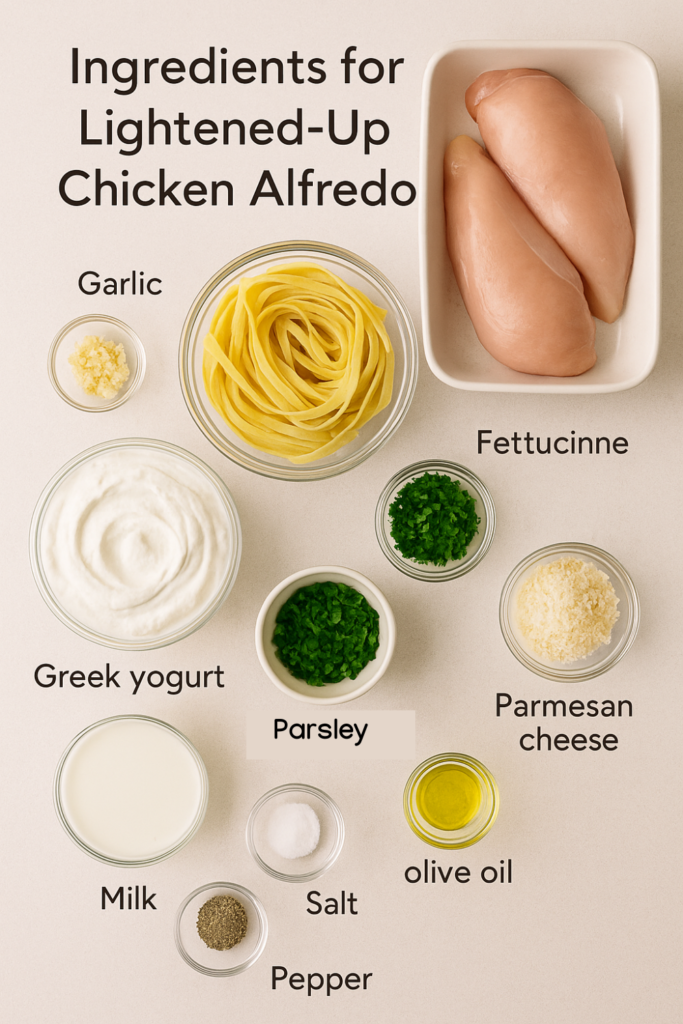
Here’s everything you’ll need to whip up this lighter, flavor-packed Chicken Alfredo:
- 2 boneless, skinless chicken breasts
- 8 oz fettuccine or pasta of choice (try whole-grain or gluten-free if you like)
- 1 tablespoon olive oil
- 3 cloves garlic, minced
- 1 cup low-sodium chicken broth
- 1 cup plain, whole-milk Greek yogurt
- ½ cup freshly grated Parmesan cheese
- 1 teaspoon Italian seasoning
- Salt and pepper to taste
- Fresh parsley, chopped (optional for garnish)
Helpful Tool Tip:
A non-stick skillet like this best-seller makes cooking the chicken much easier and prevents sticking without the need for excess oil.
🛒 Tools That Make This Recipe Easier
- Non-Stick Skillet – perfect for evenly cooking chicken with less oil
- Silicone Whisk – helps create a creamy sauce without clumps
- Microplane Grater – a must for finely shredded Parmesan
- Spiralizer – great for zucchini noodle substitutions
- Garlic Press – speeds up prep and maximizes flavor
Step-by-Step Instructions
1. Cook the Pasta
Boil a large pot of salted water and cook your pasta according to package instructions until al dente. Drain and set aside, reserving about ½ cup of the pasta water.
2. Prepare the Chicken
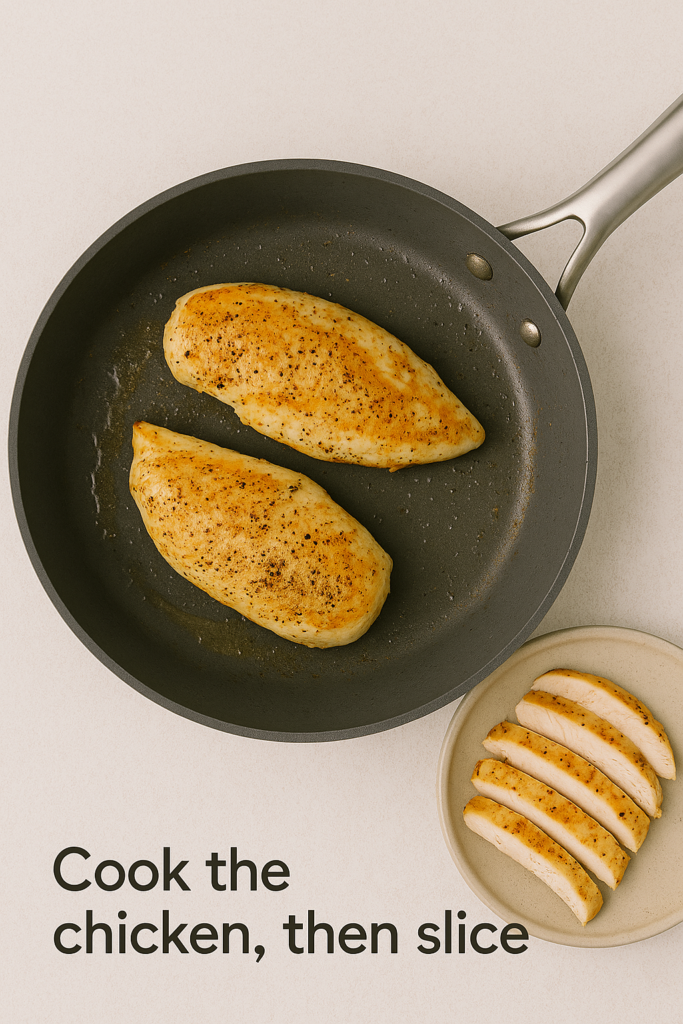
While the pasta cooks, season the chicken breasts with salt, pepper, and Italian seasoning.
Heat olive oil in a skillet over medium heat. Add chicken and cook for 5–7 minutes per side until golden and cooked through. Remove and slice into thin strips.
3. Make the Sauce
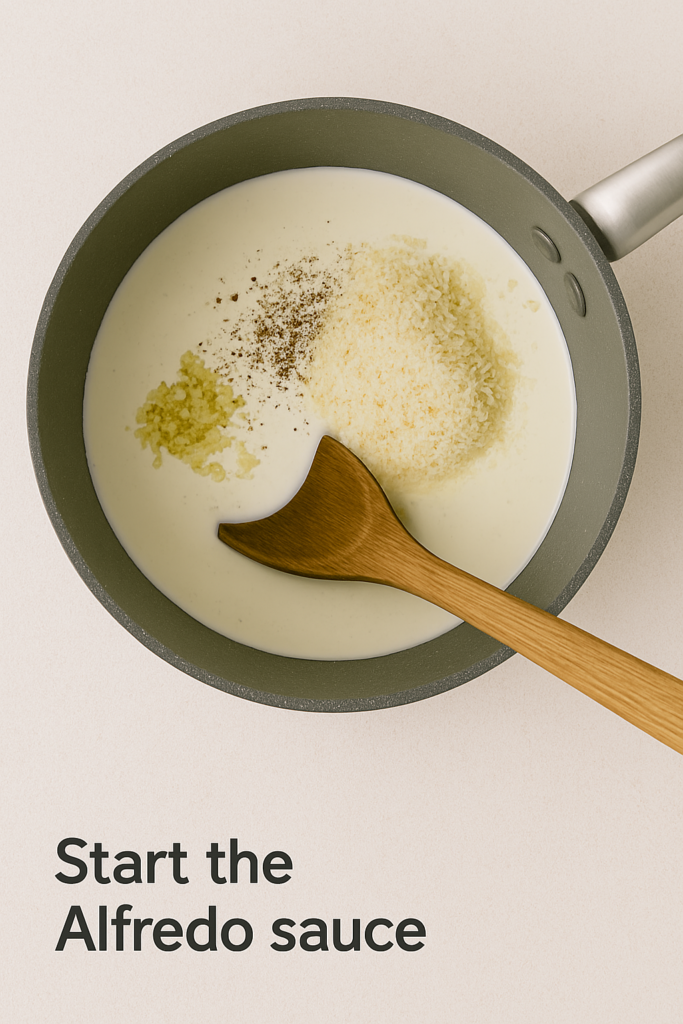
In the same skillet, sauté the minced garlic for about 30 seconds until fragrant.
Pour in the chicken broth and bring to a simmer. Lower the heat and stir in the Greek yogurt and Parmesan cheese. Stir continuously to create a creamy sauce.
4. Combine Everything

Toss the cooked pasta into the sauce, adding reserved pasta water as needed to thin it out.
Stir in the chicken strips and coat everything in the luscious sauce.
5. Serve and Enjoy!
Top your lightened-up Chicken Alfredo with chopped parsley and extra Parmesan if you like.
👩🍳 Tips for the Creamiest Chicken Alfredo (Without the Heavy Cream!)
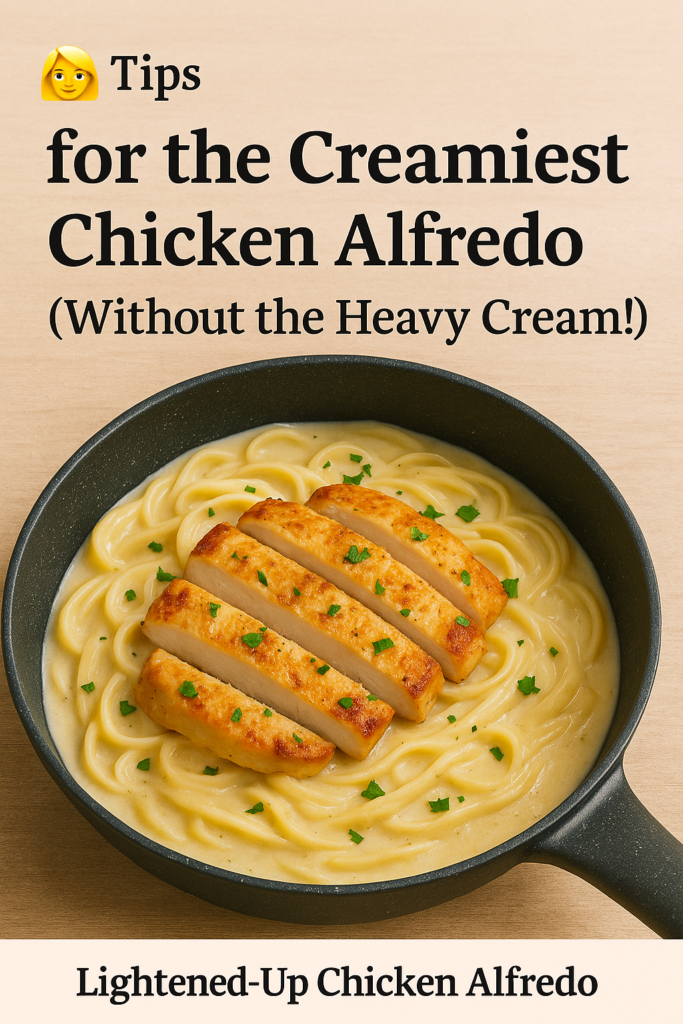
Getting a lightened-up Chicken Alfredo sauce to taste just as rich and luxurious as the original takes a few smart techniques. Greek yogurt is an incredible substitute, but it requires a little finesse to get that ultra-smooth, velvety texture.
Here’s how to perfect your creamy sauce — every single time:
1. Use Full-Fat Greek Yogurt (Not Fat-Free!)
When it comes to texture and stability, full-fat Greek yogurt is your best friend.
Fat-free versions are more likely to curdle when heated and lack the richness needed to mimic the feel of heavy cream.
✔️ Pro Tip: Whole milk Greek yogurt contains just the right amount of fat to create that lush, restaurant-style Alfredo feel — without overpowering the dish.
🧪 According to Healthline, the fat in whole Greek yogurt helps prevent separation when exposed to heat[^1].
2. Let the Yogurt Come to Room Temperature First
Adding cold yogurt directly into a hot pan can cause it to seize or separate.
Instead, let it sit out for 10–15 minutes before cooking so it blends more easily into the warm broth or pasta water.
✔️ Bonus: Stir it in off the heat, or reduce heat to low, to protect its creamy consistency.
3. Stir Continuously While Adding Yogurt to the Sauce
Once the broth or garlic base is simmering, turn the heat down and slowly whisk in the Greek yogurt, stirring constantly to prevent curdling.
If the sauce looks slightly separated at first — don’t panic! Keep stirring and it will smooth out.
🛠️ A silicone whisk is ideal for emulsifying sauces gently without scratching your pan.
4. Add Pasta Water to Adjust the Texture
Pasta water is your secret weapon for perfecting Chicken Alfredo sauce. The starches released during boiling help the sauce stick to the pasta and add a natural silkiness.
Start by adding 2–4 tablespoons, and adjust to your desired thickness.
✔️ This also helps loosen the sauce if it thickens too much after sitting.
5. Grate Your Own Parmesan Cheese (Always!)
Pre-shredded Parmesan may contain anti-caking agents that prevent proper melting. For the smoothest, creamiest texture, grate your Parmesan fresh using a microplane or fine grater.
🧀 Look for aged Parmesan or Parmigiano Reggiano for deeper flavor.
This small change makes a massive difference in overall sauce quality.
🛠️ A fine handheld grater is easy to use and perfect for pasta nights.
6. Avoid Boiling the Sauce Once Yogurt Is Added
High heat is the #1 reason sauces made with Greek yogurt break or become grainy.
Once your yogurt is stirred in, keep the heat low and avoid bringing it to a full boil. A gentle simmer is all you need to melt the cheese and marry the flavors together.
7. Add a Pat of Butter at the End (Optional)
For those who still crave a touch of indulgence, adding just a small pat of unsalted butter at the end can bring back that classic Alfredo richness — without compromising the lightened-up profile.
It emulsifies beautifully into the sauce and adds a silky finish.
8. Serve Immediately for Best Results
Like most cream-based sauces, Chicken Alfredo is best enjoyed fresh. Greek yogurt-based sauces tend to thicken as they sit, so serve right after mixing for the smoothest texture.
If you’re meal prepping, store the sauce separately and reheat gently, adding a splash of broth or milk to loosen it up.
By following these creamy Chicken Alfredo tips, you’ll turn Greek yogurt into a dreamy, luscious sauce that feels anything but light.
With the right ingredients and a few cooking tricks, your pasta night will taste like a cheat meal — but fuel you like a healthy one..
🔄 Smart Swaps and Additions to Customize Your Chicken Alfredo

One of the best things about this lightened-up Chicken Alfredo is how versatile it is.
Whether you’re catering to dietary needs, sneaking in more veggies, or simply making do with what’s in your kitchen, these smart swaps and creative add-ins make it easy to keep the meal fresh, balanced, and satisfying every time.
Use these ideas to tailor your Chicken Alfredo to your taste — and make it your own!
🧂 Pasta Swaps to Fit Your Goals
While classic fettuccine is the go-to for Chicken Alfredo, it’s not your only option.
You can easily match your pasta base to your dietary goals without sacrificing taste or texture.
| If You Want To… | Try This Instead |
|---|---|
| Go low-carb | Zucchini noodles (zoodles) or spaghetti squash |
| Add fiber | Whole-wheat fettuccine or lentil pasta |
| Stay gluten-free | Brown rice pasta or chickpea pasta |
| Save time | Pre-cooked fresh pasta from the refrigerated aisle |
🛠️ A spiralizer makes prepping zoodles a breeze — perfect for quick low-carb pasta nights.
🥦 Veggies That Pair Beautifully with Chicken Alfredo
Add color, texture, and nutrients to your meal with simple veggie toss-ins.
This is a great way to stretch your dish into a full one-pan meal while keeping it hearty and nourishing.
Delicious veggie add-ins:
- Sautéed spinach or kale
- Roasted broccoli florets
- Sliced mushrooms
- Steamed peas or asparagus tips
- Diced sun-dried tomatoes for a Mediterranean twist
🛠️ Roasting your veggies on a non-stick baking mat like helps preserve texture without needing extra oil.
🍗 Protein Swaps for Variety
Classic Chicken Alfredo is made with grilled or pan-seared chicken breast, but don’t be afraid to mix things up with other proteins.
| Protein Option | Why It Works |
|---|---|
| Rotisserie Chicken | Quick, easy, and full of flavor |
| Grilled shrimp | Adds a seafood flair and cooks in minutes |
| Sautéed mushrooms | A meaty, plant-based substitute |
| Turkey breast | Lean, juicy, and rich in protein |
| Tofu or Tempeh (for plant-based) | Soaks up the creamy sauce beautifully |
This makes it easy to adapt your Chicken Alfredo to meatless Mondays, pescatarian diets, or simply to use up leftovers.
🧀 Cheese Options for a Flavor Boost
While Parmesan is traditional, you can mix in or substitute other cheeses to bring a new flavor profile to your dish.
Tasty cheese mix-ins:
- Asiago or Romano for a sharper bite
- Fontina for a meltier texture
- Goat cheese for creaminess and tang
- A dash of nutritional yeast (for a dairy-free cheesy flavor)
🛠️ Use a box grater with multiple surfaces like to prep several cheeses at once without switching tools.
🍋 Bonus Flavor Additions
Want to level up your Chicken Alfredo without extra calories?
Add a burst of freshness and aroma with these quick finishing touches:
- Zest of one lemon + a squeeze of juice
- Cracked black pepper and red chili flakes
- Chopped fresh basil or parsley
- Toasted pine nuts for crunch
These additions elevate your dish to feel gourmet — no extra butter or cream required.
🥣 For Leftovers: Reinvent Your Alfredo
Got leftovers? Your lightened-up Chicken Alfredo sauce makes the perfect base for other creative meals:
- Alfredo pizza with grilled veggies and a whole-wheat crust
- Alfredo baked pasta — just add roasted veggies and pop into the oven
- Stuffed bell peppers with Alfredo chicken and quinoa
- Creamy Alfredo wrap with chicken, spinach, and sun-dried tomatoes
📦 Store leftovers in airtight glass containers like these stackable sets to keep flavors fresh for up to 4 days.
With these smart swaps and simple additions, you can turn your Greek yogurt Chicken Alfredo into a highly customizable, better-for-you favorite.
Whether you’re looking to pack in more protein, cut back on carbs, or add a veggie boost, there’s a version of this creamy dish that’s perfect for you and your family — without ever compromising on taste.
🥗 Nutrition Benefits: Why This Version Wins
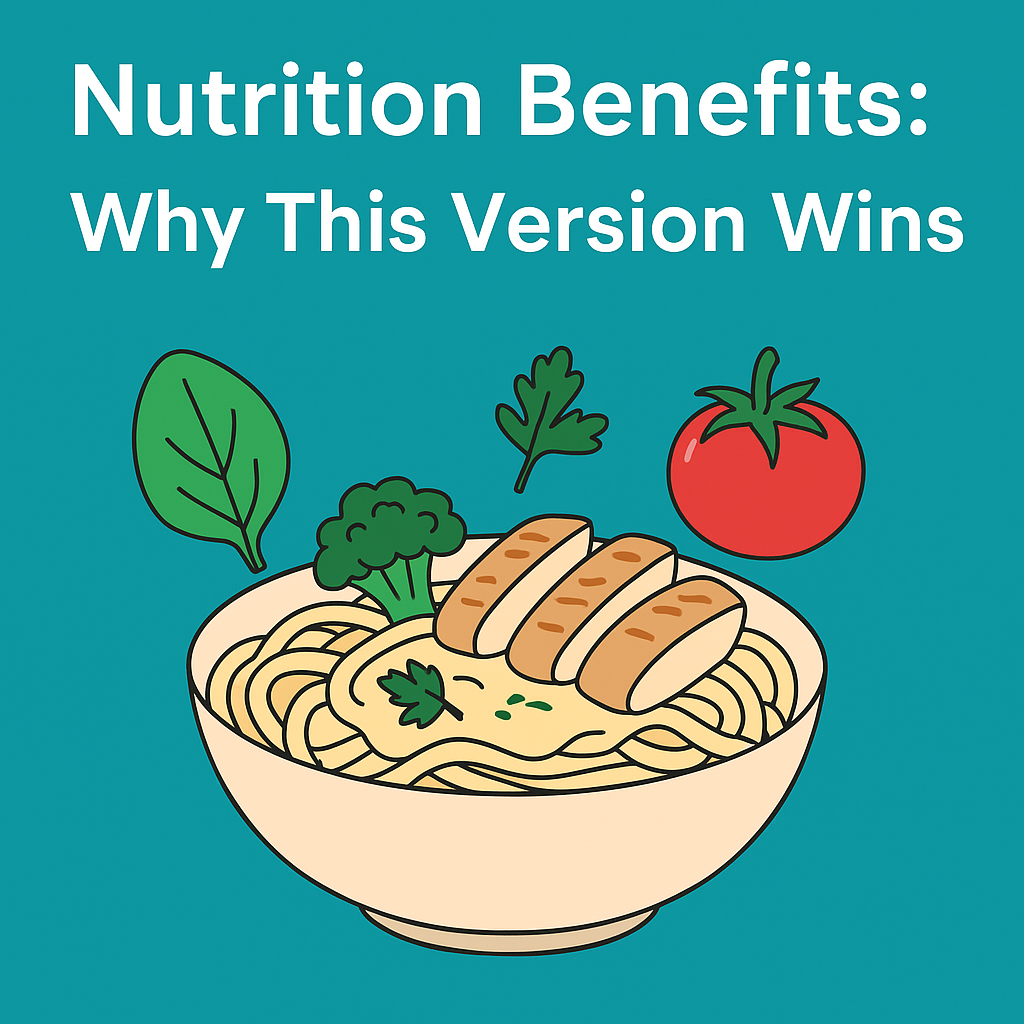
We get it — Chicken Alfredo isn’t exactly what comes to mind when you think of “healthy eating.”
The traditional version is notoriously heavy, high in fat, and often leaves you feeling sluggish and bloated after just one serving. But when you swap out a few key ingredients — like replacing heavy cream with Greek yogurt — you unlock a healthier, more energizing version of this classic comfort food.
Here’s exactly why this lighter Chicken Alfredo wins from a nutrition standpoint — without sacrificing flavor.
🔥 1. Fewer Calories, Same Comfort
The average restaurant-style Chicken Alfredo dish contains 1,000–1,200 calories per serving — and that’s not including breadsticks or a glass of wine.
Our Greek yogurt version cuts that number nearly in half, coming in at around 500–600 calories, depending on your portion size and added ingredients.
Why it matters:
Lower calorie meals that still feel indulgent are key to sustainable healthy eating. You get the satisfaction without the crash — or the guilt.
🧪 According to the USDA, 1 cup of heavy cream contains over 800 calories and 88 grams of fat. Greek yogurt, on the other hand, has roughly 220 calories and just 11 grams of fat per cup[^1].
💪 2. Higher Protein = Better Satiety
One of the most powerful changes in this lightened-up Chicken Alfredo is the boost in protein.
Between the chicken breast and the Greek yogurt base, this dish delivers over 40 grams of high-quality protein per serving — compared to just 30–35 grams in a standard recipe.
Why it matters:
Protein keeps you feeling full longer, helps stabilize blood sugar, supports lean muscle mass, and can even aid in weight management.
📊 The American Journal of Clinical Nutrition notes that protein-rich meals increase satiety and decrease snacking later in the day[^2].
🛠️ If you’re serious about tracking your macros, a digital kitchen scale like this compact one helps portion your protein with precision.
🌱 3. Less Saturated Fat = Heart-Friendlier
Heavy cream and butter are high in saturated fat, which has been linked to higher cholesterol levels and increased risk of heart disease when consumed in excess.
By using olive oil and Greek yogurt — both rich in heart-healthy fats — you’re creating a dish that supports cardiovascular health without giving up that creamy richness.
✔️ Want even more benefits? Pair this dish with a side of leafy greens tossed in olive oil and lemon for an extra dose of antioxidants and fiber.
🦠 4. Gut-Friendly Probiotics in Every Bite
Unlike cream or butter, Greek yogurt provides probiotics — beneficial bacteria that support a healthy gut microbiome.
A healthy gut is linked to everything from stronger immunity to better mental health and digestion.
Why it matters:
A balanced gut helps your body absorb nutrients more efficiently, fight off illness, and may even improve mood and cognitive function.
🧬 Harvard Health Publishing highlights that probiotic-rich foods like yogurt can promote digestive balance and immune strength[^3].
To protect those probiotics, stir the yogurt in over low heat and avoid boiling — this preserves their active cultures.
⚖️ 5. A Better Carb-to-Protein Ratio
Traditional Chicken Alfredo leans heavily on refined pasta and fat, with protein playing a supporting role.
This lightened version balances that out, creating a more macro-friendly meal with better energy distribution.
Why it matters:
Balanced meals with the right mix of carbs, fat, and protein support more stable blood sugar levels and consistent energy — no post-pasta crash.
🛠️ Want to upgrade even more? Swap regular pasta for protein pasta or whole wheat versions to increase fiber and micronutrients.
🍴 Nutrition Comparison Snapshot
Here’s a quick look at how this lightened-up Chicken Alfredo stacks up nutritionally compared to the classic version:
| Nutrient | Traditional Alfredo (1 serving) | Lightened Version (1 serving) |
|---|---|---|
| Calories | ~1,200 | ~550–600 |
| Protein | ~35g | ~45g+ |
| Total Fat | ~75g | ~18–22g |
| Saturated Fat | ~40g | ~6–8g |
| Probiotics | ❌ None | ✅ Present |
| Fiber (with swaps) | ~2g | ~6–8g (with whole grain pasta) |
All estimates based on standard ingredient portions. Actual nutrition may vary.
Final Takeaway
The beauty of this Chicken Alfredo makeover lies in its balance:
You still get a rich, creamy, comforting dish — but now it’s packed with nutrients your body can actually use to thrive.
It’s a smart, satisfying meal that works whether you’re fueling a workout, feeding a family, or simply craving something cozy without going overboard.
So go ahead and enjoy that second helping — your body (and taste buds) will thank you.quality protein, making this Chicken Alfredo a powerhouse meal for energy and satiety.
There’s no need to give up your favorite comfort food when it can be reimagined into a nourishing, satisfying dish like this Creamy Chicken Alfredo Lightened Up with Greek Yogurt.
With a few simple swaps and a little creativity, you can enjoy every bite guilt-free — and maybe even go back for seconds.
If you’re looking to elevate your kitchen game, check out the handy tools linked throughout this post to make preparing this lighter Chicken Alfredo even more effortless and enjoyable.
Ready to make it tonight? Save this recipe and share it with your fellow pasta lovers!
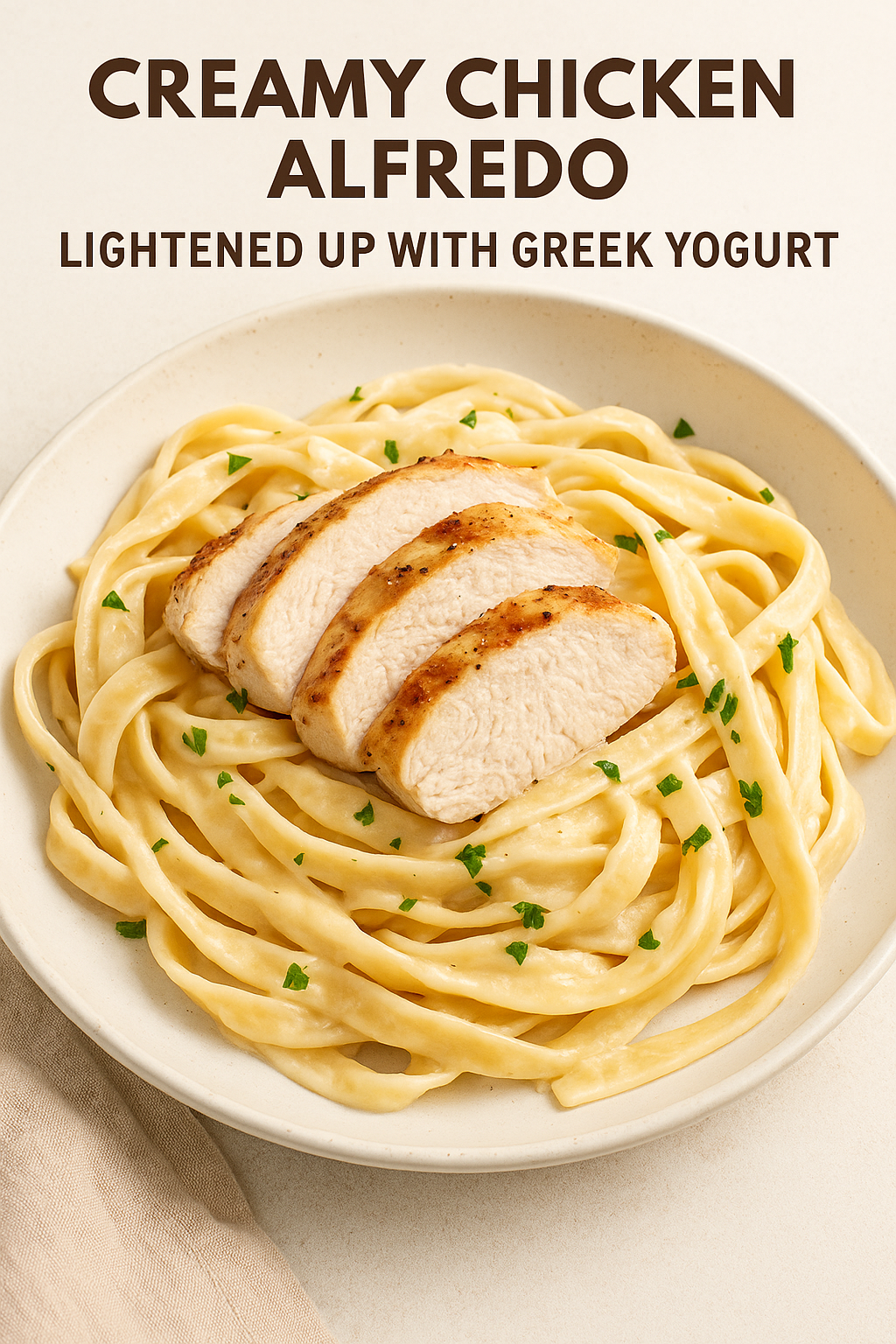
Creamy Chicken Alfredo Lightened Up with Greek Yogurt
Ingredients
Equipment
Method
- Cook the pasta according to package instructions until al dente. Reserve ½ cup pasta water before draining.
- Season the chicken with salt, pepper, and Italian seasoning. Heat olive oil in a skillet over medium heat and cook chicken for 5–7 minutes per side. Remove and let rest before slicing.
- Sauté garlic in the same skillet for 30 seconds. Add chicken broth and simmer.
- Lower the heat, then stir in Greek yogurt and Parmesan cheese. Stir continuously until smooth.
- Add pasta to the sauce, using reserved pasta water to thin if needed.
- Top with sliced chicken and garnish with parsley. Serve immediately.
- Calories: 550
- Protein: 45g
- Fat: 18g
- Carbs: 40g
- Sugar: 3g
- Fiber: 3g
Notes
Footnotes
- U.S. Department of Agriculture, FoodData Central – Cream, fluid, heavy whipping
https://fdc.nal.usda.gov/fdc-app.html#/food-details/173410/nutrients - Leidy, H. J., et al. (2015) – The role of protein in weight loss and maintenance, American Journal of Clinical Nutrition
https://doi.org/10.3945/ajcn.114.084038 - Harvard Health Publishing (2021) – The benefits of probiotics
https://www.health.harvard.edu/staying-healthy/the-benefits-of-probiotics
One-Pot Healthy Chicken Pasta Recipe That Will Save You Time & Calories
As an Amazon Associate, I earn from qualifying purchases.

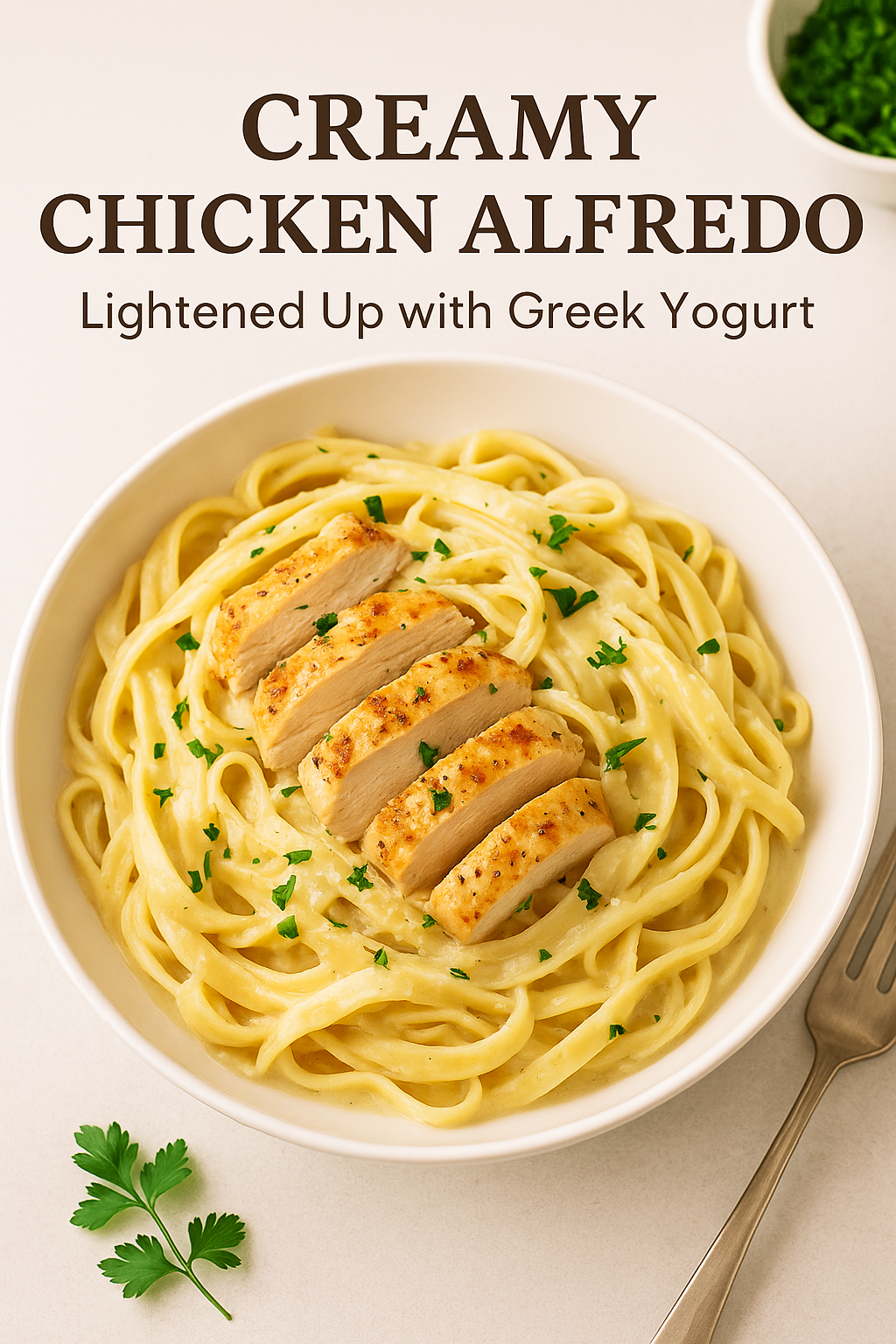









The article provides a detailed comparison between heavy cream and whole milk Greek yogurt, highlighting the latter as a healthier and more versatile option for creating creamy sauces. It’s fascinating how Greek yogurt can mimic the richness of heavy cream while offering added nutritional benefits like probiotics and lower calorie content. The tips on handling Greek yogurt in sauces, such as avoiding high heat and using specific kitchen tools, are practical and useful for everyday cooking. I appreciate the emphasis on meal prep and the creative suggestions, like substituting cheeses or adding greens for extra nutrients. However, I wonder if there are specific types of Greek yogurt that work best for these sauces or if any brand will do? It seems like Greek yogurt is a game-changer in the kitchen—have you tried it in other dishes beyond sauces? What’s your go-to way to use it creatively? Let’s exchange ideas!
Thank you for such a thoughtful and engaging comment! I’m glad the tips resonated with you—Greek yogurt really is a versatile kitchen staple. For sauces, I recommend sticking with plain whole milk Greek yogurt for the best texture and flavor. Some brands are thicker or tangier than others, so if you’re experimenting, start with one you already enjoy eating on its own.
And yes, I’ve used Greek yogurt in everything from marinades and salad dressings to baked goods and even as a base for creamy dips. One of my favorites is swapping it into mashed potatoes or using it in place of sour cream for tacos—so easy and still delicious.
I’d love to hear how you use it too—let’s definitely keep the ideas flowing!
Yogurt-based sauces seem like a healthier alternative to heavy cream, but I’m curious—does the taste really compare? I’ve tried using Greek yogurt in sauces before, and while it’s creamy, it sometimes lacks the richness of cream. The tip about stirring it off the heat is helpful, though. Do you think the probiotics in yogurt make a noticeable difference in health benefits, or is it more of a bonus? Also, what’s your go-to cheese to pair with yogurt-based sauces? I’m tempted to try this, but I’m worried it might not satisfy my cravings for something indulgent. What’s your take?
Great questions—thank you for sharing your thoughts! You’re right that Greek yogurt doesn’t have the same richness as heavy cream, but it can come pretty close, especially when paired with bold ingredients like Parmesan or a touch of butter for extra depth. Stirring it in off the heat definitely helps keep it smooth and creamy.
As for probiotics, they’re a nice bonus, though their benefits depend on how the yogurt is handled—high heat can reduce their potency, so they’re more of a perk than a guarantee in cooked dishes.
My go-to cheese for yogurt-based sauces is usually aged Parmesan for that sharp, savory punch, but I also love blending in a little cream cheese or Gruyère when I want something more indulgent. Totally get the craving for richness—this version won’t be exactly the same as heavy cream, but it’s a satisfying, lighter alternative that still feels comforting. Let me know if you try it!
This is an interesting comparison between heavy cream and Greek yogurt, especially for those looking to make healthier choices in their cooking. I appreciate the detailed tips on how to use Greek yogurt in sauces without it separating or becoming grainy. The suggestion to pair the dish with leafy greens for added nutrients is a great idea. I wonder if there are other dairy alternatives that could work just as well in these recipes. Have you tried using plant-based yogurts for similar results? Also, how do you think the flavor profile changes when substituting different cheeses? I’d love to hear your thoughts on experimenting with these variations!
Thank you so much for your kind words and thoughtful insights! I’m really glad the tips on using Greek yogurt were helpful—getting that creamy texture without curdling can definitely be tricky at first. And yes, pairing the dish with leafy greens is one of my favorite ways to boost the nutrients and add a bit of color to the plate.
As for plant-based alternatives, great question! I’ve tested a few, like unsweetened almond and coconut yogurts. Some work well, but the key is choosing one that’s thick and tangy like Greek yogurt and doesn’t have added sugars. They can be a bit more delicate with heat, so I recommend stirring them in off the heat or tempering them gently.
Swapping out cheeses is another fun area to play with—Parmesan brings that classic sharpness, but something like Pecorino Romano gives it a saltier, bolder kick. A mild goat cheese adds tang and creaminess, too. Each cheese definitely shifts the flavor profile, so it really depends on your preference!
I love hearing about experimenting in the kitchen—let me know if you try any variations!